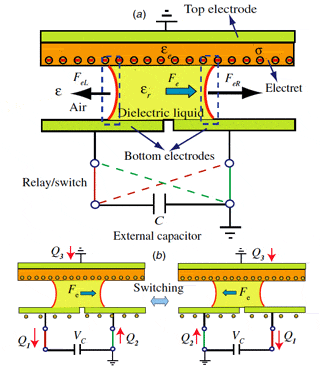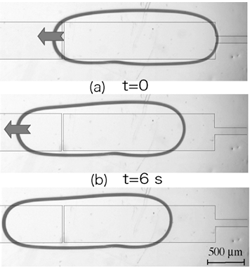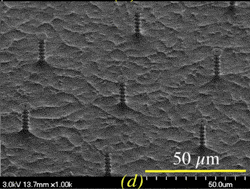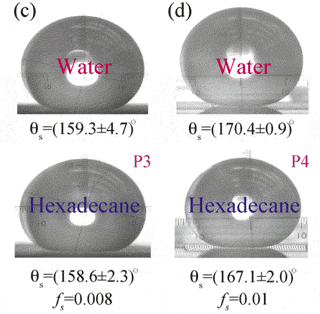Low-voltage Droplet Manipulation Using Liquid Dielectrophoresis on Electret (L-DEPOE)
Y.-C. Chen, K. Morimoto, and Y. Suzuki
Overview
In order to make droplet-based digital microfluidics really ‘digital’ and compatible with standard integrated chips (ICs), a novel low-voltage droplet manipulation method named ‘liquid dielectrophoresis on electret (L-DEPOE)’ is proposed for dielectric liquids, which initializes the possibility of digital microfluidics for IC control and broad consumer electronic applications. By employing electret as a virtual voltage source embedded into microfluidics for the first time, a dielectric droplet between two electrodes can be transported by liquid dielectrophoresis (L-DEP) force when switching an external capacitor between electrodes
using a manual switch or low-voltage-driven relays. A circuit model and force analysis for L-DEPOE are established to clarify its working principle and quantitatively depict the droplet motion. Nanoliter dielectric droplets have been transported reversibly between the two electrodes with a manual switch or five DCV-driven relays in microfabricated
proof-of-concept prototypes. The surface voltage stability of electret in liquid is examined with different polymer materials and coatings. Furthermore, the droplet motion traces in a L-DEPOE device are compared with numerical simulation results, indicating the important role of contact angle hysteresis for nanoliter droplets.
High-performance superlyophobic surfaces (SLSs) showing extremely low wettability for various liquids including water and oil are microfabricated following universal design criteria and formulated rules, and their wetting and hydrodynamic performances are systematically evaluated. Four design criteria are proposed to achieve reliable air-entrapped Cassie–Baxter (C–B) state for various liquids, especially low-surface-tension oils by considering the pressure balance and curvature requirement, as well as the
pinning and suspending condition. By formulating the geometric design rules, a T-shaped configuration with a slight undercut is preferred as robust 3D structure for microfabricated high-performance of SLS. The static and dynamic contact angles (CAs) of water and hexadecane on SLS can be well tuned by varying the solid fraction. On the high-robustness and low-adhesion SLS, CAs up to 167? for hexadecane and 170 deg. for water, and low contact angle hysteresis (CAH)∼8 deg. have been achieved. However, CAs on SLS cannot be well explained by three existing wetting models, which requires more efforts to exactly depict the droplet behavior on SLS.
Collaborator: Dr. T.-Z Wu (Sun Yat-Sen University)


Demonstration of droplet manipulation using L-DEPOE (Wu et al., 2010)


Superlyophobic surface (SLS) developed with MEMS fabrication technologies (Wu and Suzuki., 2011)
Recent Reports
Low-voltage Droplet Manipulation with L-DEPOE
- Wu, T.-Z., and Suzuki, Y.,
“Liquid Dielectrophoresis on Electret: A Novel Approach Towards CMOS-driven Digital Microfludics,”
J. Adhes. Sci. and Technol., Vol. 26, pp. 2025-2045 (2012).
(doi:10.1163/156856111X600208) - Wu, T.-Z., Suzuki, Y., and Kasagi, N.,
" Low-voltage Droplet Manipulation Using Liquid Dielectrophoresis on Electret,"
J. Micromech. Microeng., Vol. 20, Issue. 8, No. 085043, 8pp (2010).
(doi:10.1088/0960-1317/20/8/085043)
- Wu, T., Suzuki, Y., Kasagi, N., and Kashiwagi, K.,
"Oil Droplet Manipulation Using Liquid Dielectrophoresis on Electret with Superlyophobic Surfaces,"
23rd IEEE Int. Conf. Micro Electro Mechanical Systems (MEMS2010), Hong Kong, pp.1055-1058 (2010). - Wu, T., Suzuki, Y., and Kasagi, N.,
"Design and Microfabrication of High Peformance Super-Lyophobic Surfaces,"
13th Int. Conf. Miniaturized Systems for Chemistry and Life Sciences (MicroTAS 2009), Jeju, pp. 773-775 (2009).
Engineering Superlyophobic Surface for Efficient Droplet Manipulation
- Chen, Y.-C., Song, K.-Y., Morimoto, K., and Suzuki, Y.,
“Liquid-Tolerant Electret Using Super-Lyophobic Pillar Surface,”
28th IEEE Int. Conf. Micro Electro Mechanical Systems (MEMS’15), Estoril, pp. 1086-1089 (2015). - Song, K.-Y., Morimoto, K., and Suzuki, Y.,
“New Mathematical Model for Electrostatic Stability of the Cassie State on MEMS-based Pillard Surface,”
17th Int. Conf. Miniaturised Systems for Chemistry and Life Sciences (MicroTAS 2013), Freiburg, (2013). - Morimoto, K., Fukumoto, K., and Suzuki, Y.,
“MEMS-based Pillared Surface for High-speed Dropet Manipulation: Failure of Cassie-Baxter Model,”
Proc. 16th Int. Conf. Miniaturised Systems for Chemistry and Life Sciences (MicroTAS 2012), Okinawa, (2012), pp. 64-66. - Wu, T.-Z., and Suzuki, Y.,
"Design, Microfabrication and Evaluation of Robust High-Performance Superlyophobic Surfaces,"
Sensors Actuators B, Vol.156, pp. 401-409 (2011).
(doi: 10.1016/j.snb.2011.04.065) - Wu, T.-Z., and Suzuki, Y.,
“Engineering Superlyophobic Surfaces as the Novel Microfluidic Platform for Droplet Manipulation,”
Lab Chip, Vol. 11, pp. 3121-3129 (2011).
(doi:10.1039/C0LC00513D)
Last update: 2015-04-01